|

by
Michael Tellinger
2009
from Wendag Website
Presentation
by Angelique Serrao
July 14, 2008
from
WendagForums Website
A stone calendar that is apparently older than 75 000 years has been
discovered in Mpumalanga.
Adam's Calendar - as it has been
named by the two South Africans who discovered the find - is
reportedly the oldest man-made structure on Earth. This astonishing
claim, which could set the scientific world in a spin, has been made
in a picture book which is being released worldwide on Monday.
'These guys are talking nonsense'
The two authors, Johan Heine and Michael Tellinger,
are claiming that the find is older than Stonehenge and the
Giza Pyramids.
Despite renowned academics' view that the stone structure is not
what Heine and Tellinger claim it to be, the two explorers are
determined to show the world that architecture began in South
Africa.
Heine, who is a firefighting pilot, discovered the circular
structure of stones, which lies at the tip of a mountain in
Mpumalanga, when he was searching for a colleague's plane, which
went down near the site in 2003. Immediately he noticed
strange-looking stone monoliths which looked out of place in the
area.
Heine invited Tellinger, a maverick scientist who caused controversy
with his latest book, Slave Species of God, to study the
monoliths.
"We invited four or five academics
to come and look at the site, but with their typical dogmatic
thinking, they said there was no way this was a human-built
structure; they said it was just rocks," Tellinger said.
"But now geologists, archaeologists
and astrologers have all said it is something more than that."
Tellinger believes that the site ties up
with an era when human beings first started painting in caves and
started their migration into Europe and Asia from Africa between 60
000 and 70 000 years ago.
"We have evidence of early human
consciousness through cave paintings, but what about their
lives" Tellinger asked.
"This has been overlooked by
historians, and we believe that stone structures which lie all
across Southern Africa are the earliest human structures ever
made."
Tellinger said that once the world
begins to hear of Adam's Calendar, SA could become the new
Egypt, where archaeologists and astrologers will come to do research
into a whole new period of human development.
He said they dated the rocks in several ways to come to the
conclusion the stones were moved there 75 000 years ago.
"The most conclusive is the geology
report, which proves without doubt that the rocks were both
moved there from a few kilometers away and were worked with
human hands."
The monoliths are dolomite while the
bedrock is black reef cordite, said Tellinger.
"There are also clear grooves, which
someone has obviously carved onto the rock."
Heine and Tellinger found that the
monoliths were placed into exact geometrical alignments and lined up
exactly with north, south, east and west.
The two explorers also found that two of the central rocks work as a
calendar, with a tall rock casting a shadow on a shorter, flat rock.
The shadow moves across the rock in exactly one year.
Amanda Esterhuysen, a Wits University academic from
the geography, archaeology and environmental sciences department,
isn't that convinced, however.
"These guys are talking nonsense. We
are doing extensive research in Mpumalanga and these sites are
fairly well known.
"While we don't dispute that structures like this are man-made,
there is no way it is 75 000 years old. The type of science they
use to date these sites is highly questionable," she added.
Exposing The Lost City of ENKI
Part 1 of 10
June 2009
Scholars have told us that the first civilization on Earth emerged
between the rivers Tigris and Euphrates in a land called Sumer some
6000 years ago.
Recent archaeological findings suggest
that
the Sumerians may have inherited some of their knowledge and
symbolism's from an earlier civilization that emerged many thousands
of years earlier in southern Africa – the cradle of humankind.
The constant references to southern
Africa in the Sumerian texts as a ‘time before time’ leaves very
little doubt that this was the case.
The discovery of,
-
the oldest statue of
the Hawk Head of Horus, about 260,000 years old
-
petroglyphs of
winged disks with a cross
-
two pyramids aligned to Adam’s
Calendar and the rise of Orion,
...are forcing us to rewrite human
history.
Let us cast the dogma of our existing
knowledge aside and embrace the new evidence.
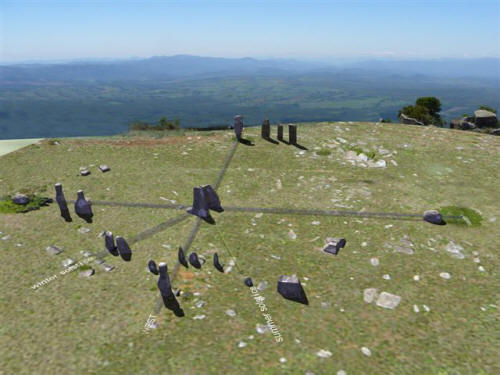
Adam’s Calendar –
Should actually be called ENKI’s calendar.
The flagship ruin at the center of the largest and most mysterious
ancient city on Earth.. The Sumerian tablets tell us that this was
a special place of observation built by ENKI in the deep ABZU
(South Africa) around 260,000 years ago.
Before the ADAMU was created.
When I wrote and released ‘Slave Species
of god’ I never realized the kind of impact it would have on people
all over the world.
I am quite overwhelmed to have received
feedback from readers in over 20 countries, describing how it has
changed their lives and allowed them to question without fear of
being punished by some invisible old man in the sky. But the biggest
surprise has been meeting Johan Heine at one of my talks which
opened up the floodgates of the next phase of my research.
When Johan first introduced me to the ancient stone ruins of
southern Africa, I had no idea of the incredible discoveries we
would make in the year or two that followed. The photographs,
artifacts and evidence we have accumulated points unquestionably to
a lost and never-before-seen civilization that predates all others –
not by just a few hundred years, or a few thousand years… but many
thousands of years.
These discoveries are so staggering that
they will not be easily digested by the mainstream historical and
archaeological fraternity, as we have already experienced. It will
require a complete paradigm shift in how we view our human history.
I see myself as a fairly open-minded chap but I will admit that it
took me well over a year for the penny to drop, and for me to
realize that we are actually dealing with the oldest structures ever
built by humans on Earth.
The main reason for this is that we have been taught that nothing of
significance has ever come from southern Africa. That the powerful
civilizations all emerged in
Sumeria and
Egypt and
other places. We
are told that until the settlement of the BANTU people from the
north, which was supposed to have started sometime in the 12th
century AD, this part of the world was filled by hunter gatherers
and so-called Bushmen, who did not make any major contributions in
technology or civilization.
Little did we realize that long before Egypt and long before Sumeria,
there was a huge ancient city in what the Sumerian tablets call
the ABZU (southern Africa). The lost and the first city of
ENKI - the
Sumerian deity and creator of humankind who was responsible for
cloning the species we call Homo sapiens. ABZU is often incorrectly
translated as “HELL” by those who grapple with the true meaning of
mythology.
This is far from the truth because the
ABZU was simply known as the land below the equator, where the gold
came from. Sumerian tablets tell us clearly that ENKI established a
base in the ABZU (southern Africa). This base grew into a very large
ancient city occupied by the early human slaves who toiled in the
gold mines.
We believe we have now discovered this large city he created.
At its peak it was larger than
modern-day Johannesburg, covering over 20,000 square kilometers. It
consists of well over 100,000 stone ruins still today. These were
linked by ancient roads and places of work and worship.
ENKI
controlled his gold mining operations from here and the
fortress of
Great Zimbabwe (below images) was his headquarters.
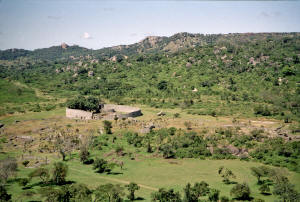 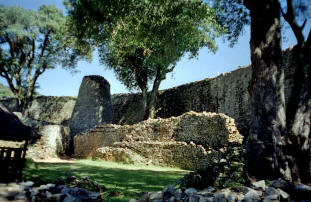
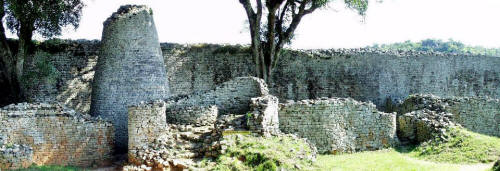
The evidence of gold mining is
everywhere in this part of the world and not only do historic
records point to this as being the first place that gold was
extracted by humans, new scientific research is there to support it.
Our research has shown that the ancient ruins of South Africa and
Zimbabwe go back to around 260,000 years the very first appearance
of humans on Earth.
I will take you on a journey of
discovery as we experienced it over the past 2 years, since late
2007.
Part 2 of 10
August 2009
This ‘African Stonehenge’ which we have called ‘Adam’s Calendar’ has
for the first time created a link to the countless other circular
stone ruins in southern Africa and suggests that these ruins are
much older than we thought.
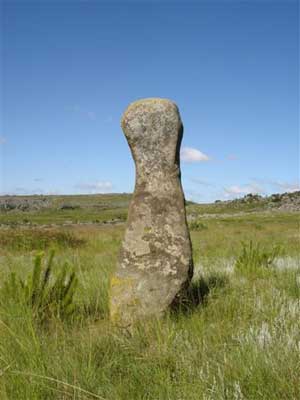
The Stone Man at
Adam’s Calendar looked out at the sunrise
at the Spring Equinox at least 160,000 years ago.
Our first calculations of the calendar
were made based on the rise of
Orion – flat on the horizon and in
line with our 3 Orion monoliths on the outer perimeter of the
calendar. But new measurements keep increasing the age. The first
calculation was at least 25,000 years which was based on the precessional wobble of Earth which completes a full cycle every
26,000 years (approx).
The next calculation was presented by a master archaeo-astronomer
who wishes to remain anonymous for fear of ridicule by the academic
fraternity.
His calculation was based on the rise of
Orion and suggested an age of at least 75,000 years. This is the
reason why we used this age on the cover of our book – Adam’s
Calendar. The most recent calculation in June 2009 suggests an age
of at least 160,000 years, also based on the rise of Orion, flat on
the horizon.
Not too far from the calendar lies the stone ruin complex that links
Waterval Boven, Machadodorp, Carolina, Badplaas and Dullstroom. This
covers an area larger then modern-day Johannesburg and has emerged
as the largest and most mysterious ancient city on Earth. It is
vital that this site be declared a World Heritage site ASAP.
The discovery of carved dolerite statues
of giant birds, some resembling Horus, and petroglyphs of winged
disks, suggests that the prototype Sumerian and Egyptian
civilizations had their origins in southern Africa thousands of
years before they emerged in the north.
But the research has also shown that these stone settlements
represent the most mysterious and misunderstood structures found to
date. The strange and confusing walled-roads that link all the
circular ruined structures are very perplexing and make no sense at
all. Why would ancient people go to all the trouble of building
roads lined along their sides with billions of stones, which had to
be carried to site from many kilometers away?
In our new book called “Temples Of The African Gods” (due for
release Jan/Feb 2010 - Zulu Planet Publishers) I propose a
whole new theory about these structures.
A theory that will probably
freak out a large number of readers because we have been taught that
we are the pinnacle of human existence and it is simply not possible
that ancient people could have had more advanced knowledge and
technology to us today. How silly and ignorant some of us can be!!!
The thousands of ancient gold mines discovered over the past 500
years, points to a vanished civilization that lived and dug for gold
in this part of the world for thousands of years. And if this is in
fact the cradle of humankind, we may be looking at the activities of
the oldest civilization on Earth.
But the calendar remains the centerpiece among the ruins. Johan
Heine discovered Adam’s Calendar in 2003, quite by accident. He was
on route to find one of his pilots who crashed his plane on the edge
of the cliff. Next to the crash site Johan noticed a very strange
arrangement of large stones sticking out of the ground.
While rescuing the injured pilot from
about 20 meters down the side of the cliff, Johan walked over to the
monoliths and immediately realized that they were aligned to the
cardinal points of Earth – north, south, east and west. There were
at least 3 monoliths aligned towards the sunrise, but on the west
side of the aligned monoliths there was a mysterious hole in the
ground – something was missing. Could that be the link to the whole
calendar site?
Weeks and months of measuring and observing the movements of the sun
Johan concluded that it was perfectly aligned with the rise and fall
of the sun. He determined the solstices and the equinoxes. But the
mysterious hole in the ground remained a big puzzle. One day, while
contemplating the reason for the hole, the local horse trail expert,
Christo, came riding by.
He quickly explained to Johan that there
was a strange shaped stone, which was removed from the spot some
time ago. Apparently it stood somewhere near the entrance to the
nature reserve.
After an extensive search, Johan found the anthropomorphic (humanoid
shape) intact and proudly placed with a plaque stuck to it. It was
used by the Blue Swallow foundation to commemorate the opening of
the Blue Swallow reserve in 1994. The irony is that it was removed
from the most important ancient site found to date and mysteriously
returned to the reserve – for slightly different reasons.
Since then we have discovered that
Adam's Calendar
is probably the
most sacred site on Earth and is well known amongst Sangomas and
Shamans. The most beloved and inspirational among this elite group
is
Credo Mutwa. In a long
interview with him in 2008, Credo told me that he was initiated at
the site in 1937 and that it was indeed the most precious and sacred
site.
He asked me with tears in his eyes:
“Mr Michael… please save this sacred
site… protect it from the greedy developers and other ignorant
people. It has to be saved for the future of humanity because
this is the place where ‘Heaven mated with mother Earth’”.
At that time I did not understand the
real meaning of Credo’s statement, and it took me another year of
research for the penny to drop and to fully understand what he
meant.
This will be revealed on the next part
of my article.
Part 3 of 10
October 2009
So why is this
Adam’s Calendar so special?
The more research we do around it, the
more we realize how important this structure is. The one thing we
could not figure out was how the calendar was linked to the
thousands of circular stone ruins in the greater part of southern
Africa.
The first estimates of the number of
stone ruins was made in 1891 by Theodore Bent who had a real
fascination with the stone ruins.
He was the first person to
document his excavations of Great Zimbabwe at the time and estimated
that there were about 4,000 stone ruins in this part of the world.
In the early 70s Roger Summers calculated around 20,000 stone ruins.
After my first year of living among the ruins and researching them
extensively, I concluded that there are at least 100,000. This was
confirmed by Prof. Revil Mason, retired head of Archaeology at the
University Of The Witwatersrand, Johannesburg. He immediately
retracted his statement when I suggested that this would put at
least 1 million people living and working here some 2000 - 4000
years ago. By the middle of 2009 I realized that we are looking at
probably around 200,000 stone ruins.
The more mountains I climbed the larger
this ancient settlement became.
You see, this is where all the earlier researchers always got
tripped up, because they did not have the benefit of aerial and
satellite photography. Thanks to Johan Heine’s work over an extended
period we could make much more accurate calculations than ever
before.
But let’s get back to the this population thing, which is a huge
problem for historians, because the population models and our
history books suggest that the there were no more than 200,000
people living in the greater part of southern Africa between 2000 –
4000 years ago. It is quite obvious that it would require a much
larger population to build so many stone structures.
One of my
favorite laughable theories, that are repeatedly presented by our
tertiary institutions and leading archaeologists, is that many of
these ancient stone settlements were built by the women and
children. Do with this theory what you want.
But the link between Adam’s Calendar and the stone ruins still
evaded us. For some reason we were under the impression that the
Barberton valley and impact crater did not have any stone ruins. The
valley is the entire flat area, surrounded by mountains, which is
overlooked by Adam’s Calendar.
Until my friend Brian Young called me
one day in great excitement, saying that he found a circle.
Fortunately for me Brian is a superb pilot who runs a flying school
right in the heart of the Barberton valley. We went flying on
several occasion and not only did we find many stone circles but
also the ancient roads that connected them all at some stage in the
distant past. We also found gold mines and many other strange
anomalies.
Suddenly it became quite obvious. If this was indeed Enki’s
calendar, at the dawn of humanity, the entire valley would have been
the main settlement and gold-mining area in the entire southern
African region. From the edge of the mountain top where the calendar
is perched, you can see the entire valley. The master looking down
on his slaves producing gold, in thousands of gold mines.
The most impressive of all would have
been a hidden mine just north of Adam’s Pyramids, perched right in
the middle of the valley. A mine that was rediscovered by
prospectors many thousands of years later, and appropriately named,
Sheba Gold Mine.
Did I say pyramids? You heard right.
We will deal with the growing body of
evidence in the next article.
Part 4 of 10
Under construction...
|





